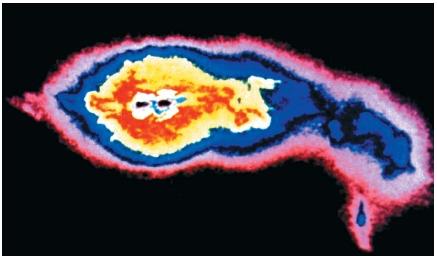White dwarf
Words to Know
Black dwarf: Cooling remnants of a white dwarf that has ceased to glow.
Nebula: Cloud of interstellar gas and dust.
Nuclear fusion: Reaction involving the merging of two hydrogen nuclei into one helium nucleus, releasing a tremendous amount of energy in the process.
Red giant: Stage in which an average-sized star spends the final 10 percent of its lifetime; its surface temperature drops and its diameter expands to 10 to 1,000 times that of the Sun.
A white dwarf is the fate awaiting the Sun and other average-sized stars. It is the core of a dead star left to cool for eternity.

Nuclear fusion is the merging of two hydrogen nuclei into one helium nucleus, with the release of a tremendous amount of energy in the process. This occurs in the early stages of every star's life. It fuels the star and provides an outward pressure that acts as a balance to the star's tremendous gravity. In the absence of fusion, gravity takes over and causes a star to collapse upon itself. The larger the original star, the smaller a white dwarf it becomes. The reason for this pattern is that larger stars have stronger gravitational fields, which produce a more complete collapse.
An average-sized star like the Sun will spend the final 10 percent of its life as a red giant. In this phase of a star's evolution, the star's surface temperature drops to between 3,140 and 6,741°F (1,727 and 3,727°C) and its diameter expands to 10 to 1,000 times that of the Sun. The star takes on a reddish color, which is what gives it its name.
Buried deep inside the star is a hot, dense core, about the size of Earth. The core makes up about 1 percent of the star's diameter. The helium left burning at the core eventually ejects the star's atmosphere, which explodes off into space as a planetary nebula (gas and dust cloud). All that remains of the star is a glowing core, a white dwarf.
The term white dwarf is a bit misleading. The core starts out white, but as it cools it displays a range of colors—from yellow to red. When all heat within the core has escaped, the body ceases to glow and becomes a black dwarf. Billions of white dwarfs exist within our galaxy, many of them now in the form of black dwarfs. These cold, dark globes, however, are next to impossible to detect.